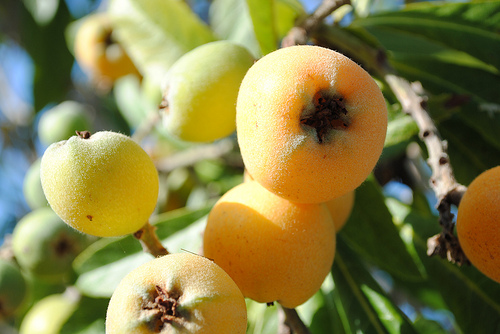Loquats are another of those great sweet and tangy combinations.
- Loquats are a variety of fruit that likely originated in China, and they were probably brought into Japan where they became very abundant and have long been cultivated.
- ‘Loquats’ are also known as ‘Japanese plums’, ‘Chinese plums’ and Japanese Medlar.
- The tree that loquats grow on has the scientific name Eriobotrya japonica, and it is from the family Rosaceae, the family of roses.
- Loquats are roughly spherical, ovoid or pear-like in shape, and they typically range between 2.5 to 5 centimetres (1 to 2 inches) in length.
- The edible skin of loquats is generally an orange or yellow colour, occasionally with a red tinge, while the flesh is usually coloured orange, yellow or white.
Loquat
Image courtesy of Larry Hoffman/Flickr
- There are more than 800 varieties of loquats, and some are grown in subtropical locations; while the world’s leading producer of the fruit in 2007 was China, producing 83% of the world’s production of 549,220 tonnes (605,411 tons).
- Loquats usually have a sweet tangy taste, and are said to taste like a combination of fruits, often tropical in flavour.
- Loquats are commonly eaten fresh, or in a fruit salad or cooked in pies, and they can be made into jams, syrups, jelly, condiments and sweets.
- Generally loquats have three to five large brown seeds in the centre of the fruit, and while they are not edible, a liqueur can be made from them.
- Loquats are high in vitamin A and are a good source of fibre, manganese and potassium, and they contain many other vitamins and minerals.
Bibliography:
Loquat, 2013, Purdue University, https://hort.purdue.edu/newcrop/morton/loquat.html
Loquat, 2016, Wikipedia, https://en.wikipedia.org/wiki/Loquat
Rawlinson L, Loquats: Here’s What You Do With Them, 2015, Full and Content, http://www.fullandcontent.com/loquats-here-s-what-you-do-with-them.html






